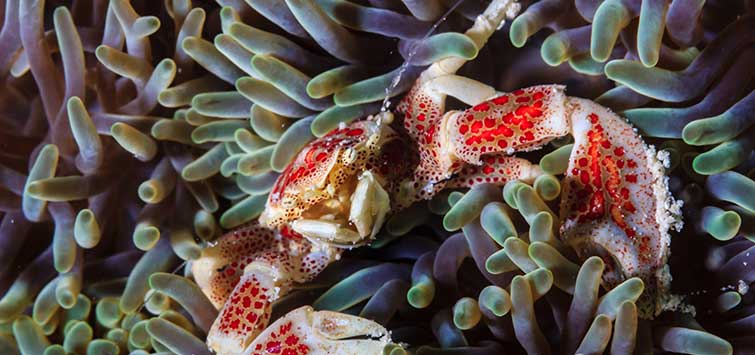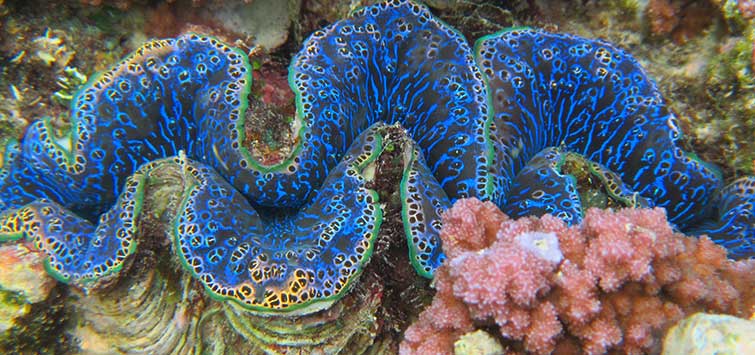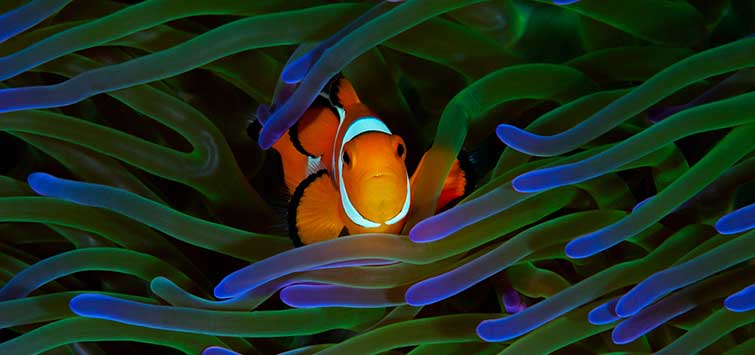The Reefer: A Look at Symbioses in the Marine Aquarium
Author: James Fatherree
In nature, various organisms have developed special interactions known as symbiotic relationships. For aquarium hobbyists, mutualistic symbiotic relationships that can be observed in aquaria are of special interest.
Symbiotic Relationship
In general, when two different types of organisms develop a close physical and/or biochemical relationship with each other, which typically lasts for life, they have developed a biological symbiotic relationship.
An Example
A couple of quick non-aquarium examples would be the suite of beneficial bacteria that live in a cow’s gut and any parasitic worms that may be there. A cow eats food to feed itself, but the bacteria and worms get some of the nutrients from the food as well. The bacteria help break down and digest the food, essentially providing a service, but the parasitic worms take some of the food for themselves without doing the cow any favors, and more likely doing it significant harm.
Three Kinds of Symbiotic Relationships
As you can see, some symbiotic relationships can be beneficial to both of the organisms involved, while others can be harmful to one organism or the other. Although I didn’t mention it in the example, there is a third type of symbiotic relationship where one party benefits and the other is neither helped nor harmed.
As I said, we’ll stick with mutualistic symbioses, which are the ones in which both organisms receive some benefit from the other. In some cases, one seems to get a lot more out of the deal than the other, and some benefits may not be obvious at all, but if it’s mutualistic, a benefit of some sort is there. And with that said, let’s look at a few.
Anemone Fishes and Anemones
The mutualistic symbiosis between anemonefishes (clownfishes) and various sea anemones is probably the best known and most conspicuous of them all when it comes to such things you can see in an aquarium. This relationship is also well known to the general public to a large degree because of the abundance of photos of these fishes frolicking in the tentacles of anemones and a certain animated movie.
Anemonefishes live among the tentacles of anemones, despite the fact that these tentacles carry stinging cells that can hurt or even kill other sorts of fishes. A stinging anemone has the ability to chemically determine if something is made of flesh or not and will typically sting most anything that it touches that’s fleshy. This can be done to capture small animal prey in order to feed itself, but it can also be an effective defense response if anything tries to eat it.
Dealing with Stings
However, there are some fishes that are relatively immune to the stings or are simply tough enough that they can take it if it means they’ll get something to eat. There are various invertebrate critters (like some crabs, sea slugs, sea stars, and worms) that can deal with the stings or avoid the tentacles altogether and will dine on the tentacles and/or the base of an anemone. So the stinging tentacles aren’t always an effective defense.
Anemonefishes
Anemonefishes, on the other hand, aren’t particularly fast swimmers as far as fishes go and are subject to predation by larger fishes. They hang out around anemones and can even sit in the tentacles themselves to keep from being eaten. While there is some debate about their exact means of pulling this off without being stung to death themselves, it seems clear that they can produce chemicals that are incorporated in the slime coating on their bodies that essentially prevent an anemone from determining they are fleshy. Thus, they don’t elicit a stinging response from the anemone.
Avoiding Predators
As much as a larger fish might want a meal, having to dive into a mass of stinging tentacles is something that they’ll typically avoid at all costs. By moving into the tentacles whenever threatened, an anemonefish can avoid being eaten without worrying about being stung. In return, the fishes help to fend off other organisms that might feed on their host anemone.
While I have not read of it occurring in the wild, I have also watched clownfishes feed their host anemone on many occasions. I’ve seen times when, after getting their fill, they’ve taken bits of fish food in their mouths and delivered it to the tentacles, after which it’s eaten by the anemone. Thus, they both help to keep each other alive and well, making this a mutualistic relationship.
Cleaner Fishes, Cleaner Shrimps, and Fishes That Get Cleaned
There are several types of wrasses, gobies, and shrimps that will clean other fishes. These cleaner species will swim/crawl over the bodies of larger, often predatory fishes, removing and eating various parasitic critters that plague them, bits of dead skin, scales, and mucus. The cleaners will also frequently go over more than a fish’s body. They’ll go into their gill area from behind the flaps that cover them, picking the gills clean. And amazing as it might sound, they’ll commonly go inside a relatively large fish’s mouth and clean it out.
These cleaner species, whether they be fishes or shrimps, get away with this because they have distinct markings and/or behaviors that let a predatory species know not to eat them. In the case of cleaner fishes, they have distinctive light and dark stripes that run the length of their body, and the shrimps typically have long white antennae.
The fishes being cleaned are very cooperative, as they’ll open up the gill-covering flaps to make access to their gills as easy as possible. They will also open their mouths as wide as possible to invite a cleaner in for a good going-over. The cleaner potentially gets a good meal out of the deal, and the fish being cleaned gets rid of parasites. Again, they help each other stay alive and well.
Shrimp Gobies and Pistol Shrimps
There are several species of shrimp gobies that live with burrowing pistol shrimps. These gobies are all relatively small in size and live on the seafloor, so having a burrow in the substrate to take refuge in would be a great defense against predation. But, none of these gobies are any good at building burrows. Therefore, it would seem that they would be easy targets for predators.
Engineering
On the other hand, the pistol shrimps are exceptional engineers that can build elaborate burrows. They don’t just dig holes; they’ll use bits of rock rubble, coral skeleton, and shell to stabilize and reinforce the inside of a burrow, similar to how humans use various materials to do the same in mines. However, these same shrimps are practically blind and would likely be picked off in an instant while roaming around outside a burrow searching for building materials.
The Relationship
To alleviate both of their problems, the two live together, with the shrimp building a home large enough for both to take refuge in and the goby hanging around the burrow’s opening and keeping a sharp eye out for any potential threats to itself or its shrimp partner. While neither typically ventures far from the burrow’s opening, when they do get out in the open, the shrimp pretty much always has one of its antennae in contact with the goby’s body. If it happens to see something getting too close for comfort, the goby will give the shrimp a warning by making a quick wiggle of its body, and both will dart into their burrow in the blink of an eye.
Feeding Time
I’ve used sinking food pellets to feed both when kept in aquariums and have seen various relatively large gobies also defend the food long enough for the shrimp to get some. When other fairly small fishes have tried to grab some of the pellets, the gobies (the yellow shrimp goby [Cryptocentrus cinctus] in particular) have sent the shrimp running temporarily and then aggressively gone after the pilfering fishes long enough for the shrimp to scoot back out and grab a meal. Again, they work together to help each other stay alive and well.
Coral Crabs and Corals
There are also a number of small crabs that live among the branches of various corals in a symbiotic relationship. These tiny crabs typically spend essentially their entire lives taking refuge among the branches of acroporid and pocilloporid stony corals, where they are relatively safe from fish predators. They also feed on mucus produced by their host coral colony and may pilfer some food particles that settle on the coral or are caught by the coral’s polyps. So, it’s a good situation for the crabs.
In return, the crabs will fend off various coral predators, like the crown of thorns starfish (Acanthaster planci). These sea stars will crawl upon a coral and eat its soft tissue, but any coral crabs present will use their claws to repeatedly pinch a star’s sucker-tipped tube feet that it uses to move around. This will often lead to the star giving up and moving on. The crabs can also play an important role in removing sediments that settle on the coral and thus help keep it clean. Yep, they both help each other stay alive and well.
Zooxanthellae, Corals, and Giant Clams
Lastly, the most prevalent symbiotic relationships are those between zooxanthellae and corals, and between zooxanthellae and giant clams. In the case of corals, most all reef-building stony corals and reef-dwelling soft corals and their kin contain huge populations of single-celled algae known as zooxanthellae, which are kept alive inside the host’s tissues.
Coral Benefits
When living in relatively clear and well-lit waters, the algae living inside a host can receive enough sunlight to make far more food (i.e., simple sugars) than they need for themselves, and this excess essentially leaches from the algae into the host’s tissue where it is taken up and used as a source of nutrition. This is why so many corals can live on very little food from the surrounding environment and why we have to put such bright lights on reef aquariums to keep corals alive.
Algae Benefits
In contrast, the corals provide the algae with a safe place to live and reproduce, and supply them with the nutrients they need to perform photosynthesis. Again, these are single-celled algae and are nothing more than another type of plankton when living outside a host’s body, meaning they’re subject to being eaten by the myriad organisms found on reefs that feed on plankton—so, they’re safer inside than outside a host.
Giant Clams
Likewise, the giant clams are quite fascinating because all of them also host large populations of zooxanthellae. In the case of the clams, the algae are housed primarily in the colorful, fleshy mantle tissue that makes clams so attractive and interesting to us. But the rest of the deal is essentially the same. The clams live in environments where they receive plenty of sunlight and provide the algae with a place to live and the nutrients they need, with the algae returning the favor in the form of excess nutrients produced by them going to the clam host’s tissues.
Mutual Relationships
And that’s just a few. Next time you see any of the organisms covered above, take a second look and give some thought to how Mother Nature can come up with some amazing and beneficial relationships between different types of organisms. They obviously aren’t all as gloomy as the typical predator-prey relationships between living things that we usually think of.
See the full article on TFH Digital http://www.tfhdigital.com/tfh/201209#pg51

.png?h=595&iar=0&w=2781&hash=5FD5E69473BCC22199FBFA2FB71B6033)



